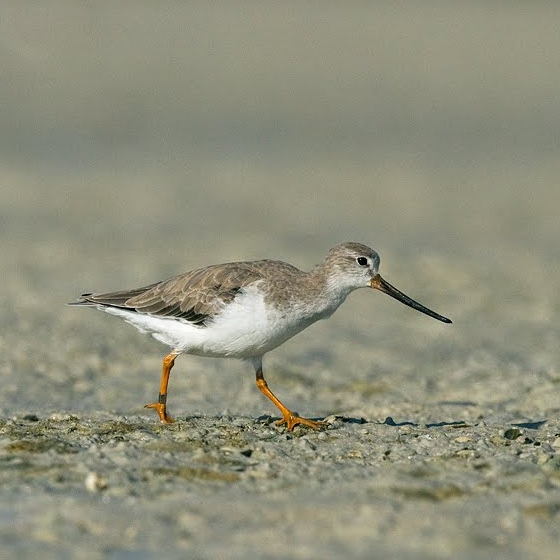Terek Sandpiper
Xenus cinereus

Introduction
A cousin to the Redshank that behaves more like a Common Sandpiper, this attractive wader breeds in open wet forest, from Finland to eastern Siberia, and is a rare visitor to Britain & Ireland.

Key Stats
Population and distribution stats for:
Status and Trends
Population size, trends and patterns of distribution based on
BTO and partnership surveys and atlasses with data collected by BTO volunteers.
Conservation Status
This species can be found on the following statutory and conservation listings and schedules.
Species of European Conservation Concern
Least Concern
IUCN Red List of Threatened Species (global)
Schedule 1 Licence required (to disturb)*
No
Birds Directive Annex 1
No
* A guide only. Check details with the original legislation, especially those marked with an asterisk.
See About Birdfacts for more information.
Population Size
First Record*
East Sussex, 1951
* First documented occurrence. Most species undoubtedly occurred before this.
See About Birdfacts for more information.
Population Change
Population trends of this scarce species are not routinely monitored.
Distribution
This species is a rare vagrant and was recorded during Bird Atlas 2007–11 as shown on the map.
Bird Atlas distribution maps show where bird species breed or winter in Britain and Ireland.
For breeding maps, larger dots indicate higher certainty the species bred in that area.
Click the map to enlarge,
or view it on Bird Atlas Mapstore.
or view it on Bird Atlas Mapstore.
To view and download up-to-date distribution information aggregated from across BTO
and partnership surveys and schemes, see our data holdings on the
NBN Atlas.
European Distribution Map
Distribution Change
This vagrant is too rarely reported to map distribution change.
Seasonality
This species has been too rarely reported to BirdTrack during 2011–22 to properly assess seasonality.
Movement
Information about Terek Sandpiper movements and migration based on online bird portals (e.g. BirdTrack),
Ringing schemes and tracking studies.
Britain & Ireland movement
View a summary of recoveries in the Online Ringing Report
Biology
Lifecycle and body size information for Terek Sandpiper, including statistics on nesting, eggs and lifespan
based on BTO ringing and nest recording data.
Survival and Longevity
Survival is shown as the proportion of birds surviving from one year to the next and is derived from bird ringing data. It can also be used to estimate how long birds typically live.
Classification, names and codes
Taxonomy, names and species codes for Terek Sandpiper
Classification and Codes
- Order: Charadriiformes
- Family: Scolopacidae
- Scientific name: Xenus cinereus
- Authority: Güldenstädt, 1774
- BTO 2-letter code: TR
- BTO 5-letter code: TERSA
- Euring code number: 5550
Alternate species names
- Catalan: siseta cendrosa
- Czech: vodouš malý
- Danish: Terekklire
- Dutch: Terekruiter
- Estonian: hallkibu e. kibutilder
- Finnish: rantakurvi
- French: Chevalier bargette
- German: Terekwasserläufer
- Hungarian: terekcankó
- Icelandic: Bjúgstelkur
- Irish: Gobadán Terek
- Italian: Piro piro del Terek
- Latvian: terekija
- Lithuanian: terekija
- Norwegian: Tereksnipe
- Polish: terekia
- Portuguese: maçarico-tereque
- Slovak: brodník sivý
- Slovenian: sabljasti martinec
- Spanish: Andarríos del Terek
- Swedish: tereksnäppa
- Welsh: Pibydd Lludlwyd
More Evidence
More evidence from Conservation Evidence.com
Partners
Birdfacts is based on data collected by volunteers participating in surveys that are organised and funded by
BTO,
RSPB,
Esmée Fairbairn Foundation,
JNCC and other partners.
Find a Species

